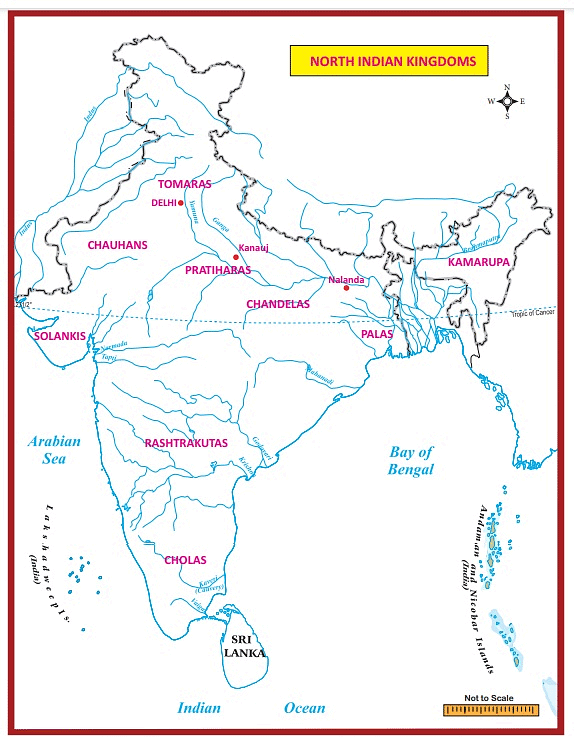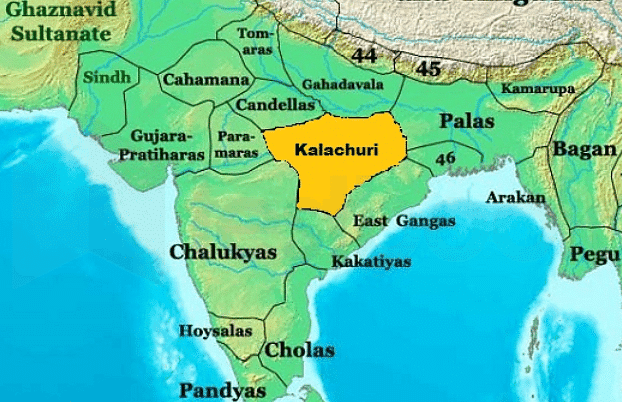Notes: New Kings and Kingdoms. | Social Studies & Pedagogy Paper 2 for CTET & TET Exams - CTET & State TET PDF Download
After the demise of Harsha, the Indian subcontinent witnessed the emergence of numerous centers of power across North India, leading to a multi-state system. Kannauj emerged as a hub of political activities in North India. Similarly, in South India, a comparable situation arose after the decline of Pallava power until the rise of the Chola Empire, which left a profound legacy through their patronage of Tamil literature and temple construction.
Major Kingdoms of the 7th to 12th Centuries CE
Following the decline of the Gupta Empire, decentralization became prominent once again. Integrated administration and political systems were lacking, resulting in the emergence of many regional kingdoms characterized by feudal elements. These kingdoms can be categorized into two groups: those in North India and those in South India. Among the kingdoms of North India, the Rajputs played a prominent role.
Important Dynasties of North India
 Indian Dynasties
Indian Dynasties
Here are the key dynasties of North India during this period:
- Gurjara-Pratihara Dynasty:
- The Gurjara-Pratihara dynasty, also known as the Pratihara Empire, was a significant Indian imperial power from the mid-7th to the 11th centuries, ruling over much of Northern India. They initially ruled from Ujjain and later from Kannauj.
- This dynasty was established by Harishchandra, but the first effective ruler was Nagbhatta. One of its most renowned rulers was Mihir Bhoj-I (AD 836-885).
- In 1018, a ruler of this dynasty was defeated by Mahmud Ghazni, leading to the decline of the dynasty.
- Gaharwal Dynasty:
- The Gaharwal dynasty was founded by Chandradev in 1085 at Kannauj. Govind Chandra emerged as one of its most successful rulers.
- Jaichand (AD 1170-1194) was the last ruler of this dynasty. He suffered defeat at the hands of Muhammad Ghori at Chandawar in AD 1194.
- Chahamanas/Chauhana Dynasty:
- Vasudeva established the main line of the Chahamanas dynasty in the middle of the AD 6th century, with Ahichchhatra as the capital.
- The most famous ruler of this dynasty was Prithviraj Chauhan-III, known for his victory in the First Battle of Tarain but subsequent defeat in the Second Battle of Tarain.
- Prithviraj's life inspired two great poems: 'Prithviraja Vijayana' and 'Prithviraj Raso' composed by his court poets Jayanaka and Chand Bardai, respectively.
- Chandella Dynasty:
- After the disintegration of the Pratihara empire, the Chandellas rose to power and ruled over Bundelkhand.
- Nannuka founded the dynasty around Khajuraho in the first quarter of the 9th century, with Yashovarman and Dhanga being notable rulers known for their temple construction activities at Khajuraho.
- Parmar Dynasty:
- The Paramaras gained prominence with Siyaka defying the authority of the Rashtrakutas.
- Bhoja, renowned for his scholastic knowledge and titled as Kaviraj, was the most celebrated ruler of this dynasty, known for his work 'Samarangansutradhara' on art and architecture.
- Solanki Dynasty:
- The Solankis, also known as the Chalukyas, ruled Gujarat and Kathiawar from AD 950 to 1300.
- Mularaja established an independent kingdom with its capital at Anahilapataka, and Bhima II was a successful ruler despite facing challenges from Mahmud of Ghazni's invasion.
- Pala Dynasty:
- The Pala dynasty, a Buddhist dynasty from Bengal, was founded by Gopala.
- Devpal, the most powerful ruler of this dynasty, expanded territories, established Vikramashila University, and renovated Nalanda University.
South India Dynasties
 South India Dynasties
South India Dynasties- Chalukya Dynasty:
- Pulkeshin I founded the dynasty, with Vatapi (modern Badami) as its capital. Pulkeshin II was a notable ruler who defeated Harshavardhan.
- The Chinese traveler Hieun-Tsang visited the Chalukyan Empire during the reign of Pulkeshin II.
- Rashtrakuta Dynasty:
- Dantidurga founded the dynasty, which initially served as feudatories of the Chalukyas of Badami. Krishna I built the famous Kailasha Temple at Ellora.
- Amoghavarsha was a notable ruler known for his interest in literature and religion, and he wrote the first Kannad poetry, 'Kaviraj Marg'.
- Pallava Dynasty:
- Singhavishnu is considered the real founder of the dynasty, with Kanchi as its capital.
- Narsimhavarman, the most successful ruler, established Mahabalipuram and was known for his patronage of arts and literature.
- During the reign of Mahendravarman, notable literary works like 'Kirtharjuniyam' by Bharvi were produced.
Ganga Dynasty
The Ganga rulers were renowned for building several famous temples:
- Narasimha Deva Varman constructed the renowned Sun Temple at Konark.
- Anantavarman built the famous Jagannath Temple at Puri.
- The predecessors of this dynasty, the Keshari rulers, erected the Lingaraj Temple at Bhubaneswar.
- Chalukya Dynasty:
In South India during this period, there was control by the Chola in Tamil Nadu, Chera in Kerala, and Pandya in South Tamil Nadu.
Administration in South India Kingdoms
Many new kings adopted grand titles such as Maharaja-adhiraja and Tribhuvana-Chakravartin. Resources were extracted from the population in the form of revenue and rent to finance various activities including maintenance of the king's establishment and construction of forts and temples.
Land Grants & Prashastis
Kings often rewarded Brahmins with land grants, recorded on copper plates with royal seals. Prashastis, similar to those during the reign of Samudragupta, were used to describe achievements, although not all writers extolled the virtues of the king; some were critical of their rule.
Conquering/Warfare for Wealth
Dynasties sought to control nearby areas to exploit their wealth, leading to conflicts. Large temples were often targeted for destruction as symbols of power. Mahmud of Ghazni raided India multiple times, targeting temples like Somnath. Other kings, including the Chauhans, engaged in warfare to expand their territories.
The Chola Empire
Around 850 CE, Vijayalaya established the Chola Empire in the Cauvery delta. His successors expanded the empire by capturing territories from Pandyan and Pallava kings. Rajaraja I and his son Rajendra-I further expanded the empire's territory and influence, including raids into the Ganga Valley and Southeast Asia.
|
75 videos|322 docs|78 tests
|
FAQs on Notes: New Kings and Kingdoms. - Social Studies & Pedagogy Paper 2 for CTET & TET Exams - CTET & State TET
| 1. What were some of the major kingdoms in South India during the 7th to 12th centuries CE? |  |
| 2. How was administration carried out in the South Indian kingdoms of the 7th to 12th centuries CE? |  |
| 3. What were some of the key features of the New Kings and Kingdoms that emerged during this period in South India? |  |
| 4. How did the South Indian kingdoms of the 7th to 12th centuries CE interact with each other and neighboring regions? |  |
| 5. What were some of the key factors that contributed to the decline of the major kingdoms in South India by the 12th century CE? |  |
















